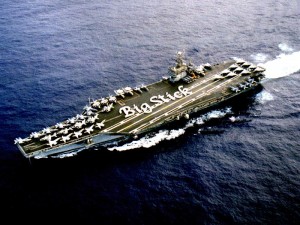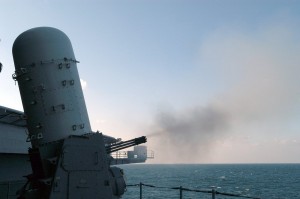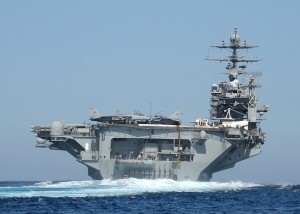Evolution of Naval Armor, Part 4: “Big Stick”
(To see all the posts in this series, click here: Naval Armor.)
In our evolution of naval armor series, we’ve so far looked at battleships – those warships built around armor and cannon, designed to be able to survive a “shootin’ match” with another warship and deal a deadly blow to their adversary. As we mentioned in Part 3, the attack on Pearl Harbor spelled the end of the battleship as the premier fighting ship of the World’s navies. The aircraft carrier, with its ability to launch scores of aircraft to project its power, has been the standard ever since. Let’s take a look at the carrier my son served on: the USS Theodore Roosevelt (CVN-71).
The Theodore Roosevelt, launched October 27, 1984, was the fourth of the Nimitz-class nuclear-powered carriers, our current class of supercarrier. The offensive power of the aircraft carrier is, of course, based on the air wing that it carries, and we won’t go into those details here. But how about defense? What does a modern aircraft carrier do to protect itself? Well, there’s not a continuation of the thicker, stronger armor paradigm. With two nuclear reactors for propulsion, the design could have called for thick steel armor all around the ship. But the ship’s designers recognized that a big, passive coat of armor was both wasteful and inefficient. There’s no armor plate, but the Theodore Roosevelt does have a double-hull design and 2.5 inch Kevlar armor around especially critical areas.
Rather, today’s carriers rely on active defensive systems to counter threats before they reach the ship.
Closest-in is the Mark 15 Phalanx, or Close-In Weapons System (CIWS, pronounced “sea-whiz”). This unit features its own searching and tracking radar control directing a six-barrel, 20 mm gatling gun. The gun fires heavy-metal (tungsten or depleted uranium) projectiles at either 3,000 or 4,500 rounds per minute. This incredible rate of fire puts a veritable wall of metal out in front of a close incoming threat such as an airplane or anti-ship missile.
Further out, up to 10 nautical miles, the Theodore Roosevelt uses the RIM-7 Sea Sparrow surface-to-air missile system for airborne threats. In addition to shooting at incoming threats, there are a number of deceptions the ship can employ, including chaff and infrared flares to confuse missile guidance systems and underwater towed decoys to defend against torpedoes. But all of these are defenses of last resort. Optimally, no threat could get close enough to challenge the ship directly. A Nimitz-class carrier has a capacity for 90 fixed wing aircraft and helicopters, some of which are offensive and some of which are employed in a defensive air umbrella around the ship.
Finally, the Navy does not send a five billion-dollar ship out to face danger alone. The carrier has never fought alone – we saw in Part 3 that part of the USS Missouri’s duties was to protect the carriers. Today, the carrier is in the center of a carrier strike group (CSG). The composition varies, but a CSG might consist of the carrier, two guided missile cruisers, two anti-aircraft warships, one or two anti-submarine destroyers or frigates and possibly a submarine. Together these ships provide mutual support, forming a multi-layered defense that would present a formidable challenge to any opponent.
Sources:
[1] USS Theodore Roosevelt Official Website
[2] USS Theodore Roosevelt, NavSource Online
[3] USS Theodore Roosevelt, Navy Site, Department of Defense
[4] USS Theodore Roosevelt, Wikipedia


